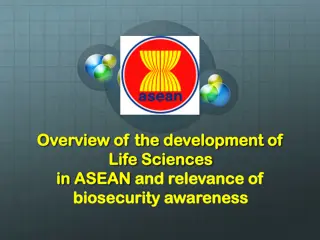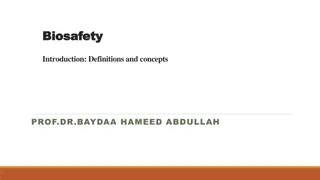Comprehensive Biosecurity Guidelines for Disease Prevention
Explore essential biosecurity concepts for disease prevention, including routes of exposure, developing a biosecurity plan, and practical application of operational measures. Learn about measures to prevent disease spread, protect daily management, and contain diseases in emergencies. Understand the importance of separating clean and dirty areas, critical control points, and different routes of disease exposure.
Download Presentation

Please find below an Image/Link to download the presentation.
The content on the website is provided AS IS for your information and personal use only. It may not be sold, licensed, or shared on other websites without obtaining consent from the author.If you encounter any issues during the download, it is possible that the publisher has removed the file from their server.
You are allowed to download the files provided on this website for personal or commercial use, subject to the condition that they are used lawfully. All files are the property of their respective owners.
The content on the website is provided AS IS for your information and personal use only. It may not be sold, licensed, or shared on other websites without obtaining consent from the author.
E N D
Presentation Transcript
Biosecurity Overview Adapted from the FAD PReP/NAHEMS Guidelines: Biosecurity (2016)
This Presentation Basic biosecurity concepts Routes of exposure Steps to develop a biosecurity plan Three levels of biosecurity Practical application of operational measures in bioexclusion and biocontainment FAD PReP/NAHEMS Guidelines: Biosecurity - Overview USDA APHIS and CFSPH
Biosecurity Concepts Measures or management practices Prevent spread of disease Protect in routine, daily management Contain disease in an emergency Individual assessment/analysis Health status and species Management and site arrangement Sources of contamination Areas needing protection FAD PReP/NAHEMS Guidelines: Biosecurity - Overview USDA APHIS and CFSPH
Separate Clean and Dirty Line of Separation Imagined or physical Pathways for disease movements Onto, off of, and within the facility Critical control points Measures to prevent transfer People, supplies, equipment, vehicles, feed, mortalities, animals Bioexclusion and/or biocontainment FAD PReP/NAHEMS Guidelines: Biosecurity - Overview USDA APHIS and CFSPH
Routes of Exposure to Disease FAD PReP/NAHEMS Guidelines: Biosecurity - Overview USDA APHIS and CFSPH
Routes of Exposure Direct Contact Direct transfer to skin, mucous membranes, wounds Aerosol Inhalation of infectious droplets Oral Ingested, consumed, environmental sources FAD PReP/NAHEMS Guidelines: Biosecurity - Overview USDA APHIS and CFSPH
Routes of Exposure contd Fomites Inanimate objects Lateral spread Vectors Living organisms Zoonotic Disease Any of the routes Disease-specific FAD PReP/NAHEMS Guidelines: Biosecurity - Overview USDA APHIS and CFSPH
Developing a Biosecurity Plan FAD PReP/NAHEMS Guidelines: Biosecurity - Overview USDA APHIS and CFSPH
Developing a Biosecurity Plan Step 1: Prioritize the disease agents Consider species/susceptibility, housing, management, wildlife exposure Step 2: Conduct a facility assessment Identify pathways/movements Step 3: Implement processes to minimize impact of disease Prevent movements that carry disease FAD PReP/NAHEMS Guidelines: Biosecurity - Overview USDA APHIS and CFSPH
Developing a Plan contd Movements of animals Closed herd is more protected Additions from offspring within the herd Managed in small, isolated groups All-in/all-out management, less co- mingling Animals that leave and return create a risk for the herd/flock Quarantines restrict movements FAD PReP/NAHEMS Guidelines: Biosecurity - Overview USDA APHIS and CFSPH
Levels of Biosecurity FAD PReP/NAHEMS Guidelines: Biosecurity - Overview USDA APHIS and CFSPH
Three Levels of Biosecurity Conceptual Location, geospatial siting, orientation of the facility Structural Capital investment, construction to prevent disease spread Operational Processes, management practices, standard operating procedures to exclude or contain disease FAD PReP/NAHEMS Guidelines: Biosecurity - Overview USDA APHIS and CFSPH
Premises Biosecurity FAD PReP/NAHEMS Guidelines: Biosecurity - Overview USDA APHIS and CFSPH
Officer, Manager, Coordinator Responsibility and authority Assesses, designs, implements Monitors and enforces Ensures ongoing effectiveness Certifies compliance Communicates and trains everyone on concepts and procedures FAD PReP/NAHEMS Guidelines: Biosecurity - Overview USDA APHIS and CFSPH
Establish Separation Line of Separation Prevent pathogens from crossing Point of access = critical control point Biosecurity measure defined for each movement Perimeter Buffer Area Transition with sanitation standard Area of reduced contamination Wider separation between clean and dirty FAD PReP/NAHEMS Guidelines: Biosecurity - Overview USDA APHIS and CFSPH
Operational Measures Fomites Decontamination People Biosecurity attire and sanitation Vectors Barriers or control programs Production traffic patterns Avoid cross contamination FAD PReP/NAHEMS Guidelines: Biosecurity - Overview USDA APHIS and CFSPH
C&D and Biosecurity Attire/PPE Cleaning and disinfection Reduces, inactivates, or destroys biological pathogens Physical, chemical, or combination Biosecurity attire/PPE Prevents transfer by outerwear Protects responder health if zoonotic FAD PReP/NAHEMS Guidelines: Biosecurity - Overview USDA APHIS and CFSPH
Biosecurity in an FAD Response FAD PReP/NAHEMS Guidelines: Biosecurity - Overview USDA APHIS and CFSPH
Zones, Areas, and Premises FAD PReP/NAHEMS Guidelines: Biosecurity - Overview USDA APHIS and CFSPH
Containment and/or Exclusion Premises designations Source of infection Enhanced risk of disease exposure Type of response activities Biocontainment and/or bioexclusion Guidance on response activities provided by Incident Command FAD PReP/NAHEMS Guidelines: Biosecurity - Overview USDA APHIS and CFSPH
Biocontainment Work Zones Separation between dirty and clean Hot Zone or Exclusion Zone (EZ) Warm Zone or Contamination Reduction Zone (CRZ) Cold Zone or Support Zone (SZ) Access is controlled Decontamination Corridor Critical control point FAD PReP/NAHEMS Guidelines: Biosecurity - Overview USDA APHIS and CFSPH
Biocontainment Work Zones FAD PReP/NAHEMS Guidelines: Biosecurity - Overview USDA APHIS and CFSPH
Decontamination Corridor FAD PReP/NAHEMS Guidelines: Biosecurity - Overview USDA APHIS and CFSPH
Protocols for Biocontainment Dirty operations at quarantined sites Understand all biosecurity protocols Identify Hot, Warm, Cold Zones Define and defend the Line of Separation Park vehicles in Cold Zone Don PPE disposable is preferred FAD PReP/NAHEMS Guidelines: Biosecurity - Overview USDA APHIS and CFSPH
Protocols for Biocontainment contd Protect electronics, to be immersed Contain and secure disposables Carry in only essentials All movements through the Decontamination Corridor Minimize unnecessary exposure C&D and doffing in Decon Corridor Tools, equipment, vehicles FAD PReP/NAHEMS Guidelines: Biosecurity - Overview USDA APHIS and CFSPH
Protocols for Bioexclusion Clean operations at non-infected sites Follow premises biosecurity plan Identify Line of Separation Animal area is clean, protected side Remove all contamination prior to entry at controlled access point Don biosecurity attire/PPE FAD PReP/NAHEMS Guidelines: Biosecurity - Overview USDA APHIS and CFSPH
Protocols for Bioexclusion contd Minimize movements and spread Begin activities with most susceptible animal group When exiting across Line of Separation, doff PPE C&D boots and all equipment Secure disposables according to the biosecurity plan FAD PReP/NAHEMS Guidelines: Biosecurity - Overview USDA APHIS and CFSPH
Conclusion Biosecurity concepts multifaceted Protect healthy animals from introduction of disease Contain disease from spreading in an outbreak FAD response efforts require both biocontainment and bioexclusion practiced correctly and consistently FAD PReP/NAHEMS Guidelines: Biosecurity - Overview USDA APHIS and CFSPH
For More Information FAD PReP/NAHEMS Guidelines & SOP: Biosecurity (2016) http://www.aphis.usda.gov/fadprep Biosecurity web-based training module: http://naherc.sws.iastate.edu/ FAD PReP/NAHEMS Guidelines: Biosecurity - Overview USDA APHIS and CFSPH
Guidelines Content Authors (CFSPH) Janice P. Mogan, DVM Heather Allen, PhD, MPA Kristen Bretz, MS Reviewers (USDA) Jonathan T. Zack, DVM James A. Roth, DVM, PhD, DACVM FAD PReP/NAHEMS Guidelines: Biosecurity - Overview USDA APHIS and CFSPH
Acknowledgments Development of this presentation was by the Center for Food Security and Public Health at Iowa State University through funding from the USDA APHIS Veterinary Services PPT Authors: Janice P. Mogan, DVM; Logan Kilburn Reviewer: Kristen Bretz, MS























